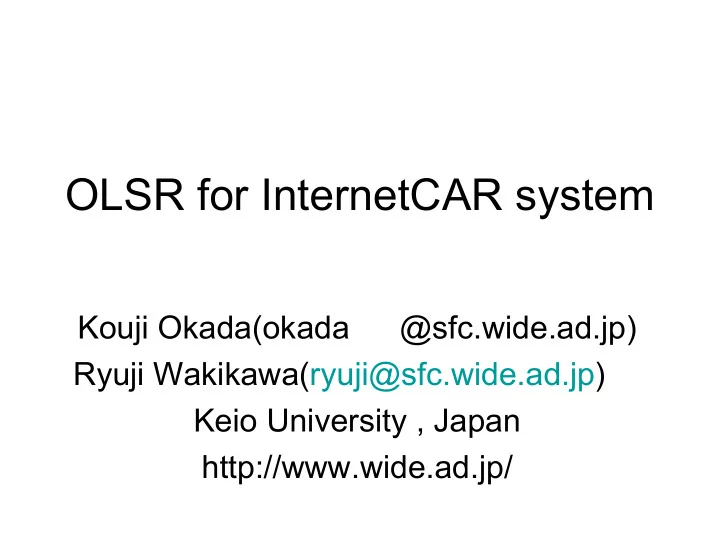

OLSR for InternetCAR system Kouji Okada(okada @sfc.wide.ad.jp) Ryuji Wakikawa(ryuji@sfc.wide.ad.jp) Keio University , Japan http://www.wide.ad.jp/
Introduction • Spread of internet connectivity – Non-computer devices have IPv6 protocol stack • Internet connectivity on automobiles – Toyota G-Book – Nissan CARWINGS – InternetCAR project
InternetCAR project • Research and deployment of internet connected environment for automobiles – Simulations, system development, network construction – IPv6 connectivity – MIPv6, NEMO, MANET • The project has large test-bed on automobiles.
NEMO Basic Support Protocol CN Internet HA Bi-directional Tunnel Binding Cache MR HoA – MR CoA MR IP-in-IP Encapsulation MNP – MR HoA MNN
Signaling Explicit Binding Update Implicit Binding Update Mobile Network Prefix Option IP header HoA IPsec BU (R) IP header HoA IPsec BU (R) MNP/len 2. Binding Acknowledgement Prefix Table MR HoA - MNP HA Internet Binding Cache MR HoA – MR CoA MNP – MR HoA 1. Binding Update MR
VI – Vehicles with the Internet
Automobile environment • Large space for multiple equipments – Communication medias – Computers inside automobiles • high-capacity battery – Almost free from the power outage
Network inside automobiles • Automobiles have about 70 computers • Three types of network in automobiles – Multimedia network(car navigation system, car audio) – Body network (headlight, power window) – Control network (engine, brake • Multimedia networks are expected to lead the implementation and the deployment of internet connectivity for automobiles • Cell-phones, wireless LAN, and DSRC are used for automobiles’ connectivity Mobile Router
Out-band connectivity on automobiles • Wide-range communication – Directly connected to the internet with cell-phones – Health check services for passengers • Short-range communication – Communication with nodes or networks nearby – Vehicle-road communication • Traffic jam information – Vehicle-vehicle communication • Video-chat between people in different cars
Problem Statement • Existing services utilize cell-phones as the communication media – Cell-phones have the narrow band connectivity • Not capable to transfer mass volume multimedia data – Limitation of the cell-phone link coverage • Lost connectivity in tunnels • Automobiles move beyond the cell-phone coverage The system to utilize both of the wide-range communication with • cell-phones and short-range communication with wireless LANs – MANET with wireless LANs for short-range communications – NEMO with cell-hones for wide-range communications.
Supposed communication environment Vehicle-road Internet network Vehicle-Internet network Vehicle-vehicle network Mobile router Vehicle-inside network
System requirement • Policy based packet forwarding – Utilizing multiple links ac cording to pre-set policies – Route management for multiple route information from each links. • Link monitor – Detect link trouble and use the active link properly • MANET edge node selection – Internet gateway selection – Acquirement of the global routable address
Policy routing • Link selection with the link monitor – Recover from loss connectivity. • Policy parameters – Throughput – RTT – Link stability • Node priority – Nodes on road-side have higher priority than automobiles because of its stability and bandwidth for internet
OLSR enhancement • Global connectivity – Route acquisition for the Internet gateway – Global routable address – Select the appropriate internet gateway • Routing based on geographical information – It is not possible to select the “best path” when each mobile router exchanges only hop counts
System overview OLSR NEMO Max hop controler Gateway selector Routing information Policy Management module Abstracted routing information Link information Link Monitor Kernel routing table Policy information Routing information Policy based routing module
System overview(cont.) • The policy management module acquire routing information from both of OLSR and NEMO • The policy management module put the policy routing information to the policy routing module • The link monitor module check the link status information and update policies in the policy management module
OLSR module • Each routing messages include the geographical information of each node • When routers get new routes, they examine RTTs for the destinations with that on cell- phones, and ignore the information if the RTT is larger than cell-phones • Internet gateway selection based on – Numbers of nodes connected – Upstream bandwidth
Policy routing module • Policy routing is based on source/destination address and port number • Policy routing module has three routing tables of throughput, RTT, and link stability • This module forward data packets according to the appropriate routing table for each traffic
Policy management module • Link monitor checks the link status of each link • This module manage the information about appropriate routing tables for each application and put it to policy routing module
Conclusion • Adapting OLSR for current InternetCAR system realizes rich automobiles communication environment • We proposed a efficient model to utilize multiple routing modules with the policy routing method
Recommend
More recommend